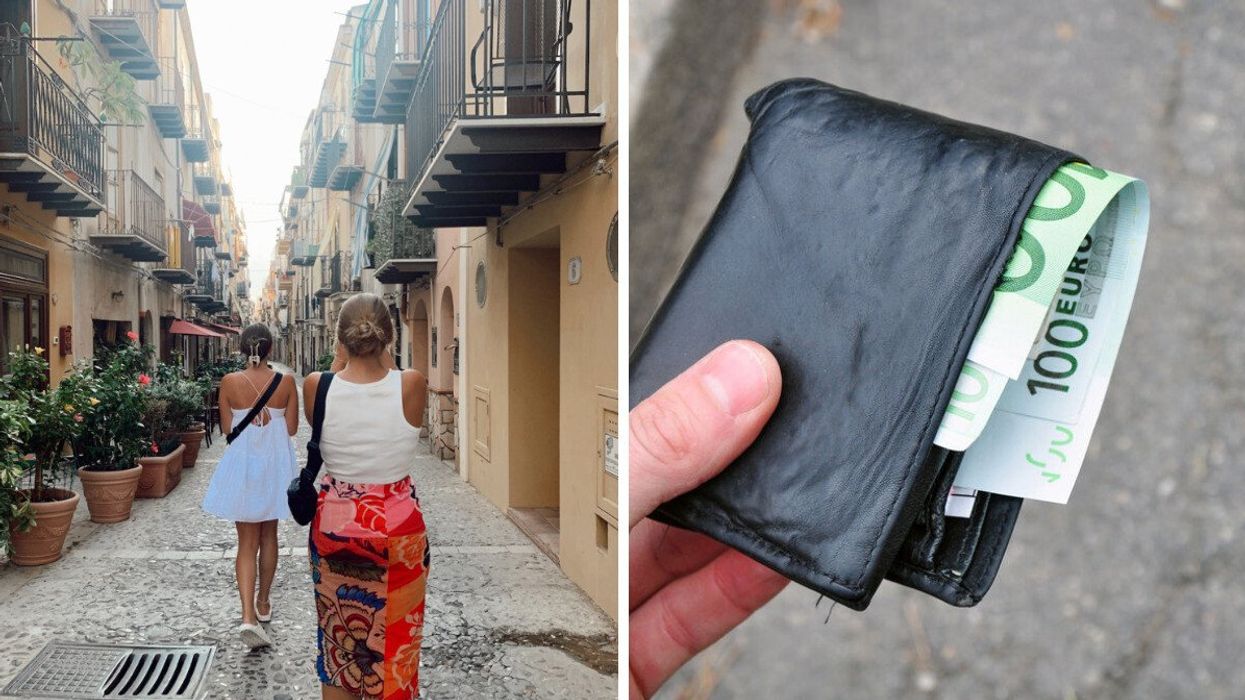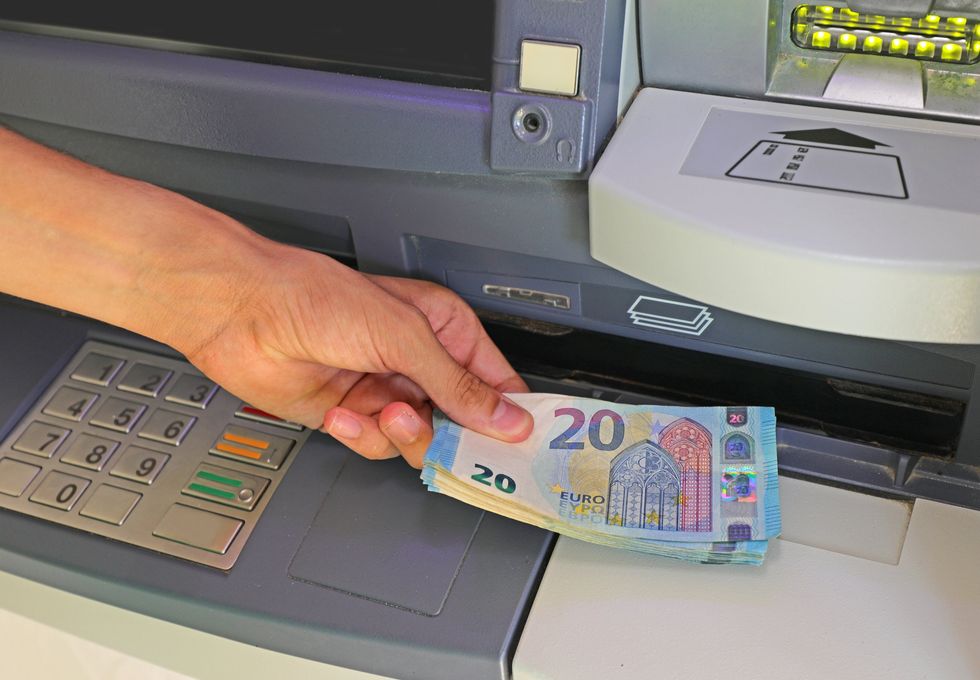6 Money Mistakes I Made While Travelling In Europe That Canadians Need To Know
Travel wisely, or it might cost you! 💸

People on a street in Italy. Right: Wallet with euros.
The views expressed in this Opinion article are the author’s own and do not necessarily reflect the views of Narcity Media.
A trip to Europe is never really going to be cheap, with the eye-watering price of flights from Canada, the euro-to-Canadian-dollar exchange rate being less than ideal for us, and everything in between.
It means that saving every penny possible is extra important, and I'm here to (hopefully) lend a hand. What makes me qualified? Many dollars wasted travelling abroad, and unfortunate lessons that I've learned.
Everything from European customs that Canadians might not know to a general lack of preparation can end up costing you, so take notes and learn from my mistakes.
Assuming the baggage allowance is the same for every flight
Canada is lacking when it comes to airlines, so there are some things I'm not quite used to when it comes to flying cheap while abroad.
On my last trip, I decided to book a cheap domestic flight in the U.K. and didn't think twice about my baggage.
While I flew Air Canada to London without a hitch, I was held up at the check-in of my next flight because of my luggage weight. Air Canada — like most airlines I've flown with in Canada — has a weight limit of 23 kilograms for a regular checked bag. My ticket with Eastern Airways only allowed for 15 kilograms though, and for every kilo over, I had to pay an extra £10.
Despite my attempts to empty all my heaviest clothes into my backpack, I still ended up paying £60 because of this mistake.
The lesson? Don't assume all airlines have the same baggage requirements, especially on those inter-Europe flights.
Not getting an eSIM
I learned this the hard way after my trip to Italy last year, and have never looked back. On that trip, I decided to just use my phone as usual while abroad, going with my phone plan's standard roaming coverage. It was $12 per day for two weeks, so not exactly a good use of money.
I justified the cost because I didn't want to buy a new SIM card and miss any important texts that may go to my usual phone number. Enter the eSIM.
This year, on my trip to Germany, I just downloaded an eSIM to my phone, which let me buy data plans so I could keep using my regular phone number and not miss any iMessages while away.
I got 3 GB of data for $13 by doing this, so it's safe to say I saved a ton.
Driving everywhere instead of taking the train
If you're travelling to multiple places around Canada, you're probably going to need to rent a car unless you want to pay big bucks for flights. Unfortunately, we lack a convenient train system here, so sometimes it slips my mind that it's actually a practical form of transportation.
In Europe, the train can take you to most places — including between countries — and it's sometimes cheaper than driving.
While planning my recent trip to Germany, I automatically assumed I'd need a car, since we were travelling around to different towns and cities. While it was convenient to have a car sometimes, it actually just ended up costing us a lot more.
Between gas and parking, plus the price of the rental car itself, you're probably better off travelling by train in most countries.
My advice is to check out train routes ahead of time and plan your trip around them.
Choosing Airbnbs outside city centres
Often a big part of European vacations is sightseeing, whether it's visiting historical monuments, looking at famous art or just walking around a city. It all sounds dreamy until you check Airbnb prices near the main attractions.
Because of this, I decided to book most of my stays in neighbourhoods outside of the city centres to make it cheaper. While there was usually a lot to do in these areas too, I found myself travelling into the downtown areas a lot.
Between public transit tickets and pricey Ubers, the cost basically evened out. Depending on what you want to do in a city while abroad, it might be worth it just to bite the bullet and stay somewhere right in the middle of the action, as opposed to spending more money (and time) later on.
Not taking out enough euros before leaving

Cash at an ATM.
Some places don't even accept cash anymore, so when travelling to Europe, I often rely heavily on my credit card. I still go with some euros in my wallet of course, but I definitely underestimated how much I would need on my last trip.
While most places do take credit cards, some require or prefer cash. How much cash you'll need depends on where exactly you're going and what you're doing, but I definitely regretted not bringing more. After using up all my euros, we had to make a dreaded ATM withdrawal and pay the hefty fees that came with it.
It's also a good idea to look into using a card that waives international transaction fees, to make sure you're saving as much as possible.
Thinking scooters are always a good deal

Lime scooters in Berlin.
Some Canadian cities have electric scooters, but they're ideal for tourists looking to see a new city, so I've only really used them while away on a trip. Everywhere we went in the big cities, we would see the Lime e-scooters scattered around, and our group hopped on them every chance we had since it was so convenient.
While it might seem easier than figuring out public transit and cheaper than ordering an Uber, that actually wasn't always the case. Since we had enough people to fill an Uber, it was almost always cheaper for us to get one and split the cost, as opposed to each of us paying for separate scooters.
Unfortunately, we were many €9 scooter rides deep before this sunk in.
The same goes for public transit. While ticket prices varied, sometimes it was actually cheaper for us to all share an Uber than to take the bus or train, and way faster and more convenient too.
So make sure to map out your route ahead of time and actually check the costs of all the different transportation options before you jet away.
At the end of the day, research and planning is key when it comes to any trip, and it can go a long way in saving you money.
Happy travels!
- Canadians Will Soon Be Charged For Visiting Europe & Here's What You Need To Know ›
- 6 European Cities That Canadians Need To Visit, According To Someone Who Grew Up There ›
- 8 Things Canadians Need To Know Before Travelling To Europe This Summer ›
- 10 tips for Canadians travelling to Europe in 2024, from visa requirements to tipping culture - Narcity ›
